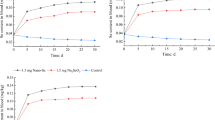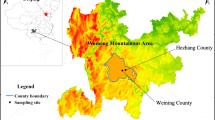Abstract
Guizhou black goats are essential to the production system in the Wumeng prairie in the Western China. This study aimed to determine the influence of nano-copper on antioxidant system in copper-deprived Guizhou black goats. We analyzed mineral contents in soil, forage, and goats’ tissues. Blood parameters were also determined. The results showed that copper concentrations in soil and forage were significantly lower, and the iron content was significantly higher in affected compared with healthy area (P < 0.01). Copper concentrations in animal tissues (blood, liver, and hair) were significantly lower and iron content was significantly higher in affected compared with healthy goats (P < 0.01). After supplementation of nano-copper or copper sulfate, copper concentration in blood was significantly increased and iron content was significantly lower (P < 0.01). Compared with nano-copper group, the effect of copper sulfate was slower. Hemoglobin levels, erythrocyte count, and packed cell volume from nano-copper and copper sulfate groups were significantly higher than those in copper-deprived goats (P < 0.01). Compared with the copper-deprived Guizhou black goats, serum ceruloplasmin levels in nano-copper and copper sulfate groups were significantly increased, while serum lactate dehydrogenase, aspartate aminotransferase, alanine aminotransferase, alkaline phosphatase, and creatinine were significantly decreased (P < 0.01). Compared with the copper-deprived animals, serum superoxide dismutase, glutathione peroxidase, catalase, and total antioxidant capacity in nano-copper and copper sulfate groups were significantly higher, while serum malondialdehyde content was significantly lower (P < 0.01). The effect of copper sulfate group was significantly lower than that in nano-copper group (P < 0.01). Consequently, nano-copper could not only markedly increase the copper content in blood in copper-deprived Guizhou black goats but also much improves the antioxidant capacity.
Similar content being viewed by others
References
Liao JJ, Shen XY, Huo B, Xiong KN (2018) Effect of nitrogenous fertilizer on the antioxidant systems of grassland species in the Karst mountains. Acta Pratacult Sin 27(1):169–176
Xia YB, Han Y, Chen SC, Wu X (2019) Effects of dietary protein concentration on production performance and rumen fermentation of Guizhou black goats aged 45-105 days. J Grassl Forage Sci 06:71–79
Shen XY, Du GZ, Chen YM, Fan BL (2006) Copper deficiency in yaks on pasture in western China. Can Vet J 47:902–906
Huo B, Wu T, Xiao H, Shen XY (2019) Effect of copper contaminated pasture on mineral metabolism in the Wumeng semi-fine wool sheep. Asian J Ecotoxicol 14(6):224–232
Jaleh B, Fakhri P, Noroozi M (2012) Influence of copper nanoparticles concentration on the properties of poly(vinylidene fluoride)/cu nanoparticles nanocomposite films. J Inorg Organomet P Mat 22(4):878–885
Lei RH, Wu CQ, Yang BH, Ma HZ, Shi C, Wang QJ, Wang QX, Yuan Y, Liao MY (2008) Integrated metabolomic analysis of the nano-sized copper particle-induced hepatotoxicity and nephrotoxicity in rats: A rapid in vivo screening method for nanotoxicity. Toxicol Appl Pharmacol 232(2):292–301
Meng H, Chen Z, Xing GM, Yuan H, Chen CY, Zhao F, Zhang CC, Zhao YL (2007) Ultrahigh reactivity provokes nanotoxicity: Explanation of oral toxicity of nano-copper particles. Toxicol Lett 175(1-3):102–110
Griffitt RJ, Weil R, Hyndman KA, Denslow ND, Powers K, Taylor D, Barber DS (2007) Exposure to copper nanoparticles causes gill injury and acute lethality in Zebrafish (Danio rerio). Environ Sci Technol 41(23):8178–8186
Chen Z, Meng H, Xing GM, Chen CY, Zhao YL, Jia G, Wang TC, Yuan H, Ye C, Zhao F, Chai ZF, Zhu CF, Fang XH, Ma BC, Wan LJ (2006) Acute toxicological effects of copper nanoparticles in vivo. Toxicol Lett 163(2):109–120
Prabhu BM, Ali SF, Murdock RC, Hussain SM, Srivatsan M (2010) Copper nanoparticles exert size and concentration dependent toxicity on somatosensory neurons of rat. Nanotoxicol 4(2):150–160
Liu YZ, Zhu LQ (2012) The biological function and absorption mechanism of nanometer CuO. China Feed 24:31–32
Huang JS, Ren S (2001) Development on nanocrystalline powder copper preparation. J Mater Sci Eng 19(2):76–79
Zhang CX, Wu HQ, Zhu XP, Jia HT (2012) Analysis of Cd pollution & spatial variability characteristics of typical agricultural soils in Suburbs of Urumqi, Xinjiang. Spectrosc Spect Anal 32:537–540
Lai YS (2016) Study on heavy metal pollution of soil and cropper in typical area. Shihezi Univ, Shihezi City
Shen XY, Huo B, Wu T, Song CJ, Chi YK (2019) iTRAQ-based proteomic analysis to identify molecular mechanisms of the selenium deficiency response in the Przewalski's gazelle. J Proteome 203:103389
Wu L, Zhang H, Xu C, Xia C (2016) Critical thresholds of antioxidant and immune function parameters for Se deficiency prediction in dairy cows. Biol Trace Elem Res 172(2):320–325
Roman M, Jitaru P, Barbante C (2014) Selenium biochemistry and its role for human health. Metallomics 6(1):25–54
Chen M, Mahfuz S, Cui Y, Jia LY, Liu ZJ, Song H (2019) The antioxidant status of serum and egg yolk in layer fed with mushroom stembase (Flammulina velutipes). Pak J Zool 52:389–392
Herena YH, Naghum A, Marla JB, Lucia AS (2019) From selenium absorption to selenoprotein degradation. Biol Trace Elem Res 192(1):26–37
Huma V, Singh VK, Singh MP (2017) Heavy metal pollution due to coal washery effluent and its decontamination using a macrofungus, Pleurotus ostreatus. Ecotoxicol Environ Saf 145(4):42–49
Zhao F, Ma Y, Zhu Y (2015) Soil contamination in China: current status and mitigation strategies. Environ Sci Technol 49(11):750–759
Popovic MP, Nie H, Chettle DR (2007) Random left censoring: a second look at bone lead concentration measurements. Phys Med Biol 52(17):53–69
Shen XY, Jiang ZG (2012) Serum biochemical values and mineral contents of tissues in Przewalskii and Tibetan gazelles. Afr J Bio Technol 11(3):718–723
Shen XY, Jiang HM (2013) Study of serum biochemical values and mineral contents of tissues in Guizhou black goat. J Anim Vet Adv 12(5):581–583
Shen XY, Chi YK, Xiong KN, Wang HC, Zhang JH (2013) Serum biochemical values and mineral contents of tissues in Guizhou semi-fine wool sheep. J Anim Vet Adv 12(11):1078–1080
Spears JW (2003) Trace mineral bioavailability in ruminants. J Nutr 133(5):1506–1509
Li SG, Wu JH, Wang QW, Wang ZW, Mo BT (2016) Studies of sulfur-and iron-induced copper deficiency in Tibetan sheep. Agric Sci Technol 17(8):1900–1902
Jiang JF, Zhang CS, Jia CY, Gao XJ (2003) The influence of various dietary Fe and Va levels on production performance, apparent deposition of iron, copper, manganese and zinc of broilers. Acta Zoonutr Sin 15(1):31–37
Shen XY, Li X, Zhang RD (2010) Studies of “unsteady gait disease” of the Tibetan gazelle (Procapra picticaudata). J Wildl Dis 46(2):560–563
Yuan R, Li L, Wang Q, Du G (2011) Copper deficiency in Guizhou semi-fine wool sheep on pasture in southwest China karst mountain area. Afr J Biotechnol 10(74):17043–17048
Wu T, Song ML, Shen XY (2020) Seasonal dynamics of copper deficiency in Wumeng semi-fine wool sheep. Biol Trace Elem Res. https://doi.org/10.1007/s12011-019-02018-5
Meng T, Liu YL, Xie CY (2019) Effects of different selenium sources on laying performance, egg selenium concentration, and antioxidant capacity in laying hens. Biol Trace Elem Res 189(2):548–555
Huo B, He J, Shen XY (2020) Effects of selenium-deprived habitat on the immune index and antioxidant capacity of Przewalski's gazelle. Biol Trace Elem Res. https://doi.org/10.1007/s12011-020-02070-6
Wu XZ, Dai SF, Hua JL, Hu H, Wang SJ, Wen AY (2019) Influence of dietary copper methionine concentrations on growth performance, digestibility of nutrients, serum lipid profiles, and immune defenses in broilers. Biol Trace Elem Res 191(1):199–206
Chi YK, Zhang ZZ, Song CJ, Xiong KN, Shen XY (2020) Effects of fertilization on physiological and biochemical parameters of Wumeng sheep in China’s Wumeng prairie. Pol J Environ Stud 29(1):79–85
Huo B, Wu T, Song CJ, Shen XY (2019) Studies of selenium deficiency in the Wumeng semi-fine wool sheep. Biol Trace Elem Res 194(1):152–158
Song CJ, Shen XY (2020) Effects of environmental zinc deficiency on antioxidant system function in Wumeng semi-fine wool sheep. Biol Trace Elem Res. https://doi.org/10.1007/s12011-019-01840-1
Liu KY, Liu HL, Zhang T, Mu LL, Liu XQ, Li GY (2019) Effects of vitamin E and selenium on growth performance, antioxidant capacity, and metabolic parameters in growing furring blue foxes (Alopex lagopus). Biol Trace Elem Res 192(2):183–195
Zhao K, Chi YK, Shen XY (2020) Studies on edema pathema in Hequ horse in the Qinghai-Tibet plateau. Biol Trace Elem Res. https://doi.org/10.1007/s12011-020-02043-9
Saban C (2019) Effect of dietary vitamin E, selenium and their combination on concentration of selenium, MDA, and antioxidant enzyme activities in some tissues of laying hens. Pak J Zool 51:1155–1161
Liu LN, Chen F, Qin SY, Ma JF, Li L, Jin TM, Zhao RL (2019) Effects of selenium-enriched yeast improved aflatoxin B1-induced changes in growth performance, antioxidation capacity, IL-2 and IFN-γ contents, and gene expression in mice. Biol Trace Elem Res 191(1):183–188
Zeng R, Muhammad UF, Zhang G, Tang ZC (2020) Dissecting the potential of selenoproteins extracted from selenium-enriched rice on physiological, biochemical and anti-ageing effects in vivo. Biol Trace Elem Res. https://doi.org/10.1007/s12011-019-01896-z
Wang Z, Zhang H, Yang H (2014) Genome-wide association study for wool production traits in a Guizhou black goat population. Plos One 9(9):e107101
Funding
This work was supported by the Project of National Key Research and Development Program of China in 13th Five-year Plan (2016YFC0502601) and the National Natural Science Foundation of China (41671041).
Author information
Authors and Affiliations
Corresponding author
Ethics declarations
Ethics statement
The Guizhou black goats that were used in this study were cared for as outlined in the Guide for the Care and Use of Animals in Agricultural Research and Teaching Consortium (Federation of Animals Science Societies, 2016). Sample collections from goats were approved by Southwest University of Science and Technology in China, Institutional Animal Care and Use Committee (Project A00657).
Conflict of Interest
The authors declare that they have no conflict of interest.
Additional information
Publisher’s Note
Springer Nature remains neutral with regard to jurisdictional claims in published maps and institutional affiliations.
Xiaoyun Shen and Chunjie Song Equal contributors, they are co-first authors.
Rights and permissions
About this article
Cite this article
Shen, X., Song, C. & Wu, T. Effects of Nano-copper on Antioxidant Function in Copper-Deprived Guizhou Black Goats. Biol Trace Elem Res 199, 2201–2207 (2021). https://doi.org/10.1007/s12011-020-02342-1
Received:
Accepted:
Published:
Issue Date:
DOI: https://doi.org/10.1007/s12011-020-02342-1




